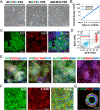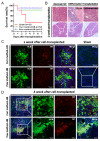Robust expansion and functional maturation of human hepatoblasts by chemical strategy
- PMID: 33632328
- PMCID: PMC7908723
- DOI: 10.1186/s13287-021-02233-9
Robust expansion and functional maturation of human hepatoblasts by chemical strategy
Abstract
Background: Chemically strategies to generate hepatic cells from human pluripotent stem cells (hPSCs) for the potential clinical application have been improved. However, producing high quality and large quantities of hepatic cells remain challenging, especially in terms of step-wise efficacy and cost-effective production requires more improvements.
Methods: Here, we systematically evaluated chemical compounds for hepatoblast (HB) expansion and maturation to establish a robust, cost-effective, and reproducible methodology for self-renewal HBs and functional hepatocyte-like cell (HLC) production.
Results: The established chemical cocktail could enable HBs to proliferate nearly 3000 folds within 3 weeks with preserved bipotency. Moreover, those expanded HBs could be further efficiently differentiated into homogenous HLCs which displayed typical morphologic features and functionality as mature hepatocytes including hepatocyte identity marker expression and key functional activities such as cytochrome P450 metabolism activities and urea secretion. Importantly, the transplanted HBs in the injured liver of immune-defect mice differentiated as hepatocytes, engraft, and repopulate in the injured loci of the recipient liver.
Conclusion: Together, this chemical compound-based HLC generation method presents an efficient and cost-effective platform for the large-scale production of functional human hepatic cells for cell-based therapy and drug discovery application.
Keywords: Chemical cocktail; Hepatic maturation; Hepatoblast expansion; Small molecules; Stemness maintenance.
Conflict of interest statement
The authors declare that they have no competing interests.
Figures





Similar articles
-
Synergistic modulation of signaling pathways to expand and maintain the bipotency of human hepatoblasts.Stem Cell Res Ther. 2019 Dec 2;10(1):364. doi: 10.1186/s13287-019-1463-y. Stem Cell Res Ther. 2019. PMID: 31791391 Free PMC article.
-
Efficiently generate functional hepatic cells from human pluripotent stem cells by complete small-molecule strategy.Stem Cell Res Ther. 2022 Apr 11;13(1):159. doi: 10.1186/s13287-022-02831-1. Stem Cell Res Ther. 2022. PMID: 35410439 Free PMC article.
-
Therapeutic efficiency of human amniotic epithelial stem cell-derived functional hepatocyte-like cells in mice with acute hepatic failure.Stem Cell Res Ther. 2018 Nov 21;9(1):321. doi: 10.1186/s13287-018-1063-2. Stem Cell Res Ther. 2018. PMID: 30463600 Free PMC article.
-
Generation of human pluripotent stem cell-derived hepatocyte-like cells for drug toxicity screening.Drug Metab Pharmacokinet. 2017 Feb;32(1):12-20. doi: 10.1016/j.dmpk.2016.10.408. Epub 2016 Oct 26. Drug Metab Pharmacokinet. 2017. PMID: 28012798 Review.
-
The role of cellular interactions in the induction of hepatocyte polarity and functional maturation in stem cell-derived hepatic cells.Differentiation. 2019 Mar-Apr;106:42-48. doi: 10.1016/j.diff.2019.02.006. Epub 2019 Mar 2. Differentiation. 2019. PMID: 30878880 Review.
Cited by
-
Chemical approaches targeting the hurdles of hepatocyte transplantation: mechanisms, applications, and advances.Front Cell Dev Biol. 2024 Oct 31;12:1480226. doi: 10.3389/fcell.2024.1480226. eCollection 2024. Front Cell Dev Biol. 2024. PMID: 39544361 Free PMC article. Review.
-
Kupffer cells abrogate homing and repopulation of allogeneic hepatic progenitors in injured liver site.Stem Cell Res Ther. 2024 Feb 20;15(1):48. doi: 10.1186/s13287-024-03656-w. Stem Cell Res Ther. 2024. PMID: 38378583 Free PMC article.
-
C/EBPβ Coupled with E2F2 Promoted the Proliferation of hESC-Derived Hepatocytes through Direct Binding to the Promoter Regions of Cell-Cycle-Related Genes.Cells. 2023 Feb 2;12(3):497. doi: 10.3390/cells12030497. Cells. 2023. PMID: 36766839 Free PMC article.
-
Functional human iPSC-derived alveolar-like cells cultured in a miniaturized 96‑Transwell air-liquid interface model.Sci Rep. 2021 Aug 23;11(1):17028. doi: 10.1038/s41598-021-96565-4. Sci Rep. 2021. PMID: 34426605 Free PMC article.
-
Generation of Hepatobiliary Cell Lineages from Human Induced Pluripotent Stem Cells: Applications in Disease Modeling and Drug Screening.Int J Mol Sci. 2021 Jul 30;22(15):8227. doi: 10.3390/ijms22158227. Int J Mol Sci. 2021. PMID: 34360991 Free PMC article. Review.
References
-
- Saito Y, Ikemoto T, Morine Y, Shimada M. Current status of hepatocyte-like cell therapy from stem cells. Surg Today. 2021;51(3):340–9. - PubMed
-
- Li Z, Wu J, Wang L, Han W, Yu J, Liu X, Wang Y, Zhang Y, Feng G, Li W, Stacey GN, Gu Q, Hu B, Wang L, Zhou Q, Hao J. Generation of qualified clinical-grade functional hepatocytes from human embryonic stem cells in chemically defined conditions. Cell Death Dis. 2019;10(10):763. doi: 10.1038/s41419-019-1967-5. - DOI - PMC - PubMed
Publication types
MeSH terms
LinkOut - more resources
Full Text Sources
Other Literature Sources

